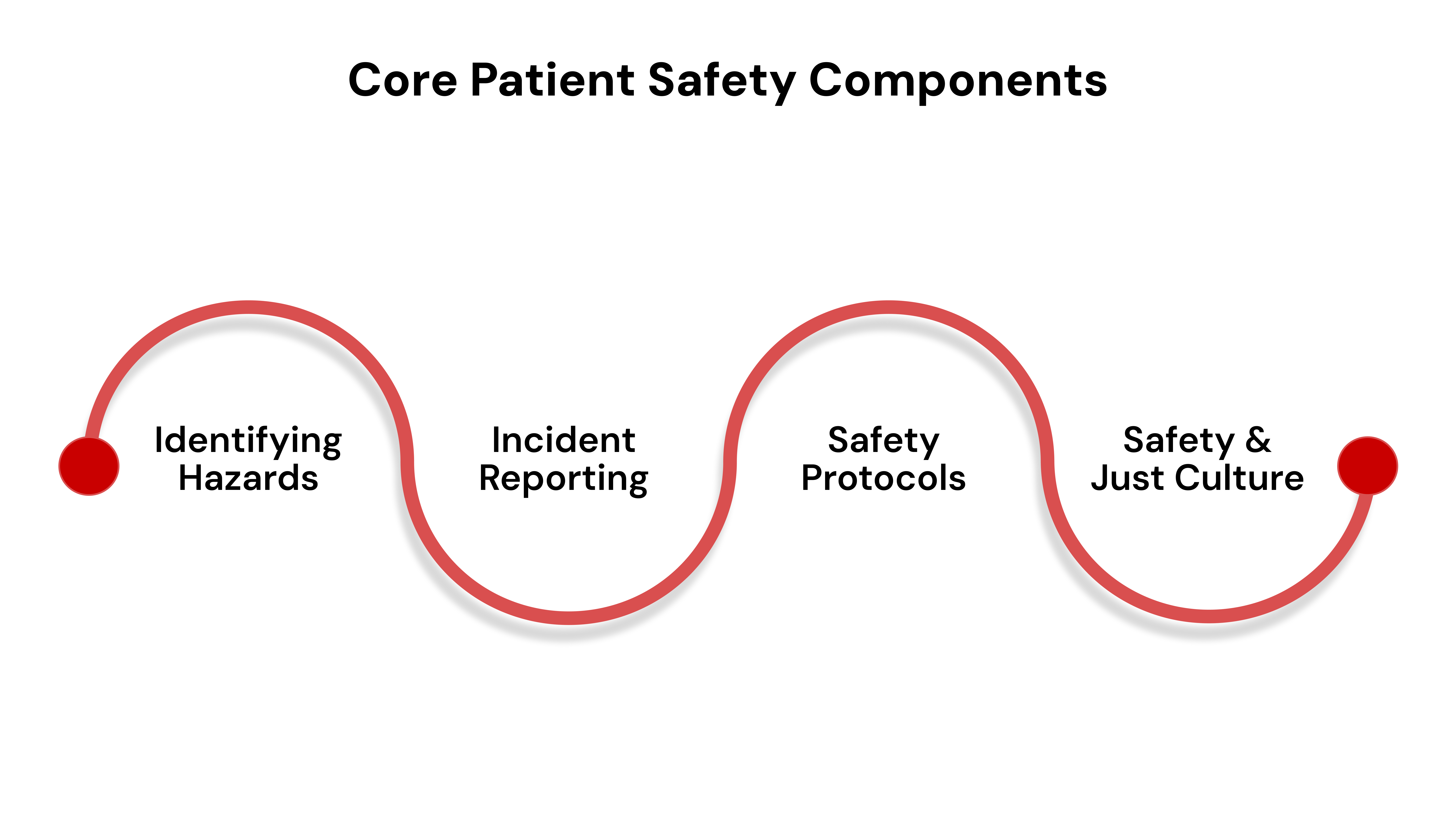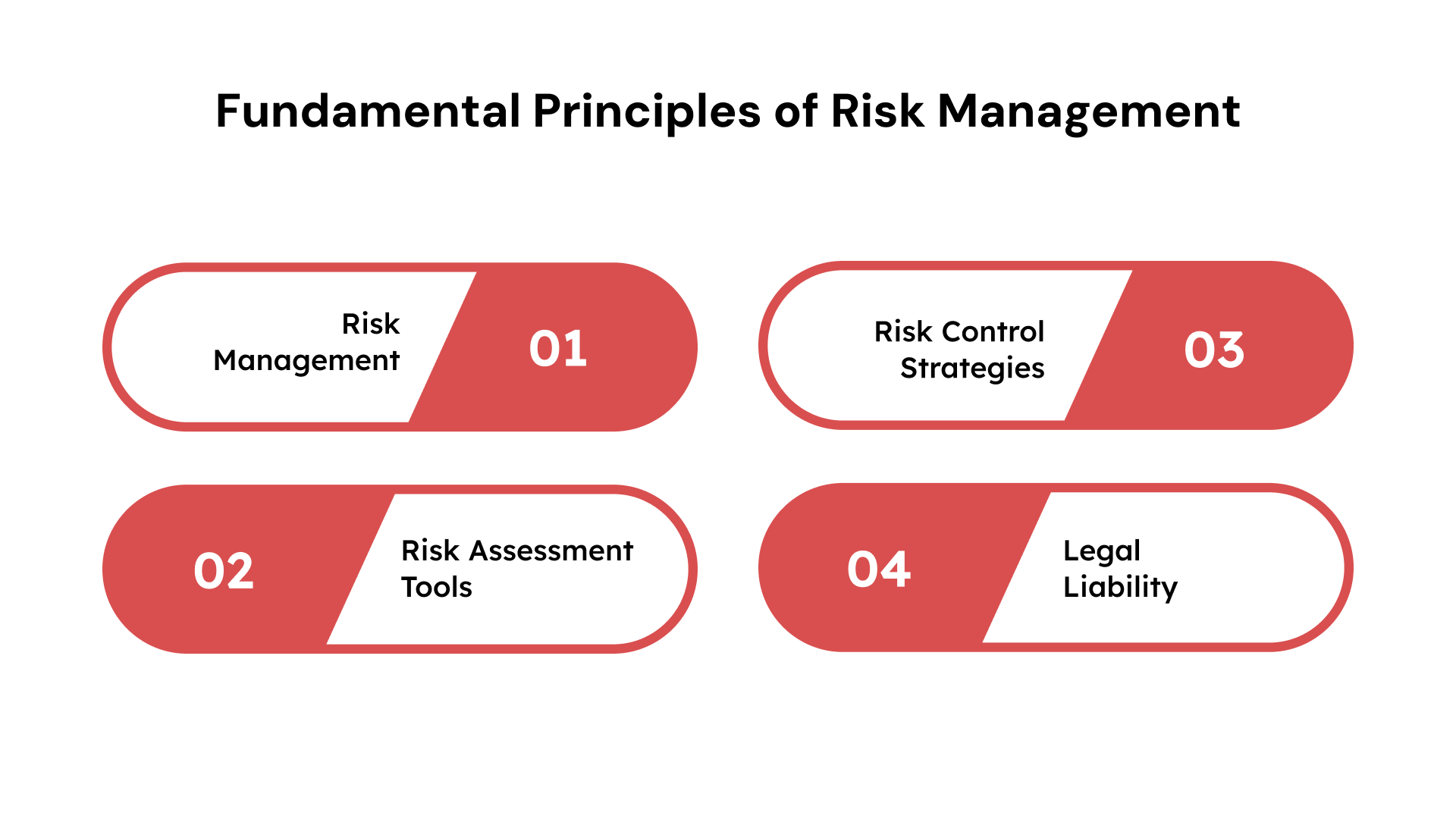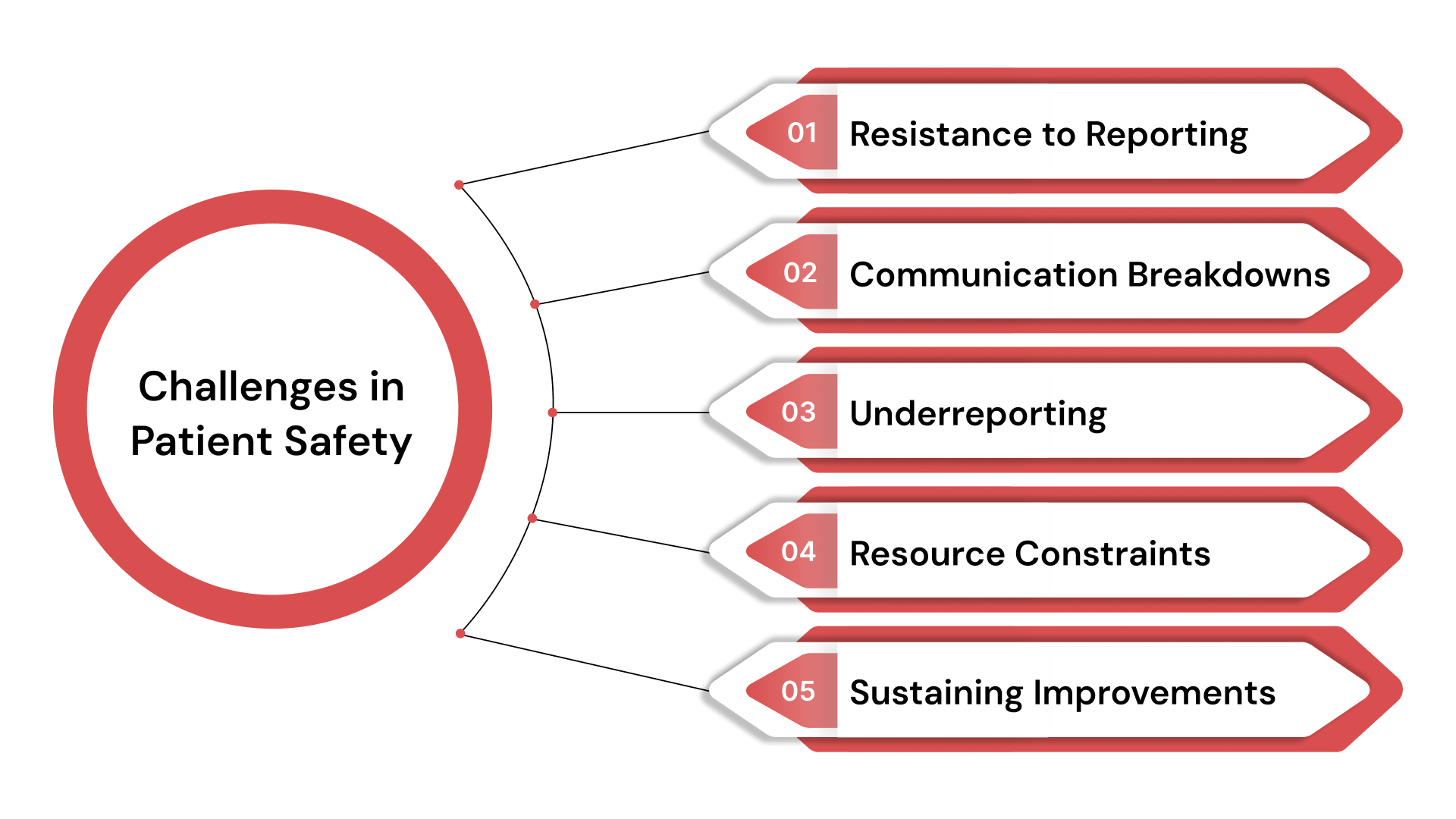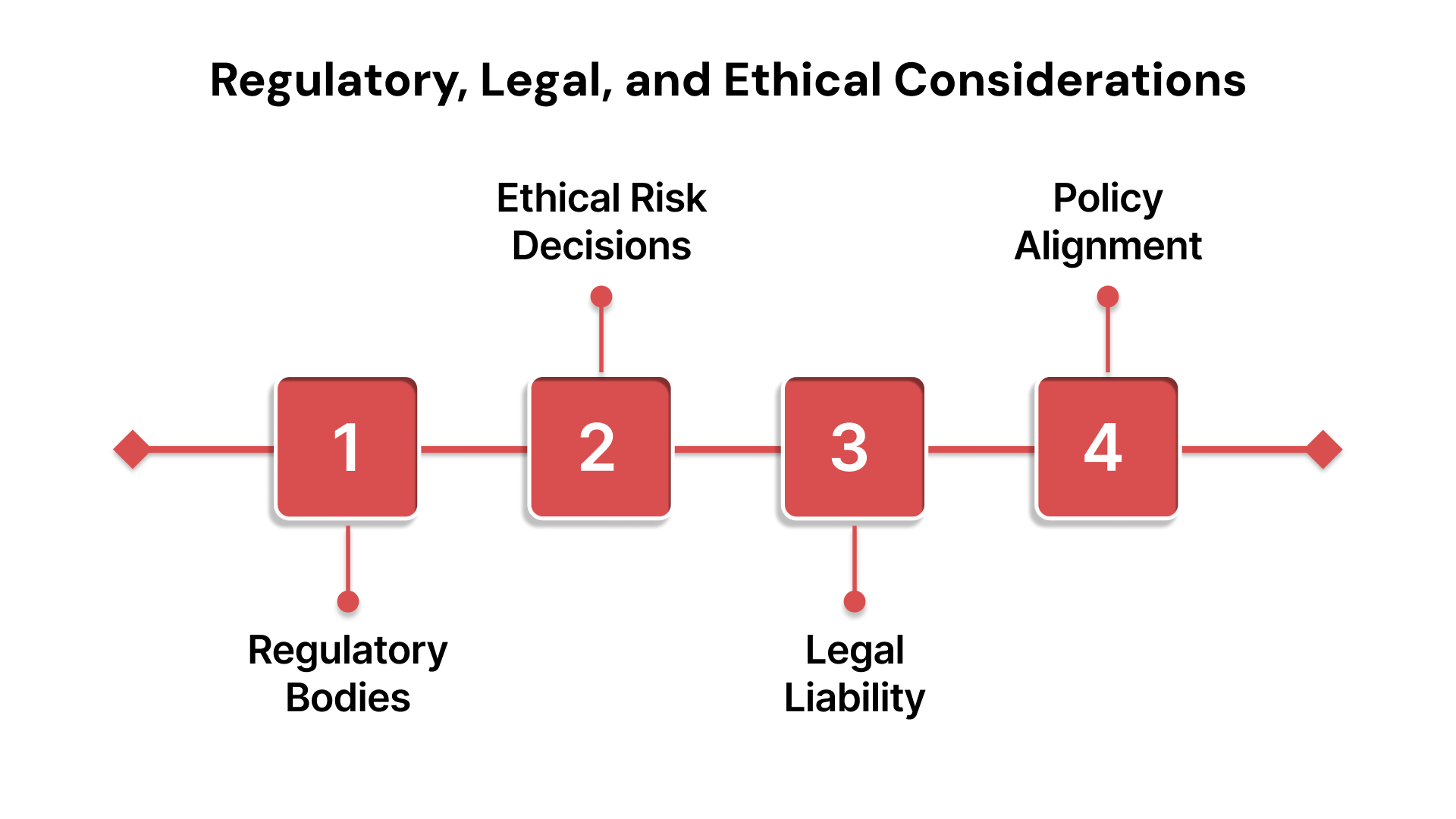Fundamentals of Patient Safety and Risk Management in Healthcare
When systems fail in healthcare, the impact can be personal, public, and lasting. Preventable harm or non-compliance with safety protocols can lead to devastating consequences and quickly erode trust. Patient safety focuses on minimizing harm during care by preventing errors, standardizing procedures, and fostering accountability. Risk management, on the other hand, involves identifying and addressing potential threats that could affect patient care or the organization’s integrity. Together, these two disciplines work to reduce harm, ensure regulatory compliance, protect the organization’s reputation, and use data to prevent future risks. When properly aligned, they help healthcare systems move from reactive fixes to proactive, resilient care.

Every decision in healthcare carries weight, not just clinical, but legal, reputational, and operational. For compliance officers and risk leaders, the stakes are even higher. One overlooked incident, one missed protocol, can wipe years of trust and expose the organization to serious liability.
Yet many are still managing patient safety and risk through outdated workflows, siloed systems, and reactive reporting.
Globally, unsafe care contributes to over 3 million preventable deaths each year, a sobering reminder that patient safety isn’t optional. It’s a mandate. In a sector where lives are at stake and regulations never rest, ensuring safety must be proactive, systematized, and data-driven.
That’s where patient safety risk management becomes both a shield and a strategy, protecting care outcomes while reinforcing institutional integrity.
In this article, we’ll explore the core components that define patient safety and how healthcare leaders can embed smarter risk practices into every layer of clinical operations.
Key Takeaways
- Patient safety and risk management must work together to prevent harm, improve care quality, and ensure regulatory compliance.
- Preventable harm often stems from system-level failures, making structured protocols, communication, and accountability essential.
- Effective risk management starts with identifying threats early, ranking them, and applying consistent mitigation strategies backed by data.
- Safety and compliance efforts break down when reporting is discouraged, communication is inconsistent, or tools are fragmented.
- Embedding safety into daily workflows, using smart reporting tools, and aligning policies with standards like HIPAA or CMS builds long-term resilience.
What is Patient Safety and Risk Management in Healthcare?
When systems fail in healthcare, the consequences are personal, public, and often permanent. Preventable harm, operational lapses, or non-compliance with safety protocols can result in devastating outcomes and erode trust in an instant. The responsibility to prevent these failures is urgent, continuous, and deeply tied to how healthcare organizations manage risk.
Patient safety is the discipline of minimizing harm to patients during care delivery. It focuses on preventing avoidable errors, standardizing procedures, and promoting a culture of accountability. From surgical safety checklists to medication reconciliation, patient safety is about making every touchpoint reliable and risk-aware.
Risk management in healthcare, on the other hand, is the structured process of identifying, analyzing, and mitigating potential threats in clinical, legal, financial, or operational areas that could compromise patient care or organizational integrity.
Together, patient safety and risk management work to:
- Reduce incidents of harm and adverse events
- Strengthen regulatory compliance and audit readiness
- Safeguard organizational reputation and stakeholder confidence
- Enable better use of data to predict and prevent future risks
When aligned, these two disciplines turn reactive fixes into proactive, system-wide resilience.
Core Components of Patient Safety

Preventable harm is rarely the result of a single failure; it’s the outcome of gaps across systems, communication, and accountability. When every second counts and scrutiny is constant, fragmented safety processes only heighten risk exposure. A proactive, structured approach to patient safety is essential for preserving trust and meeting compliance standards.
At the core of effective patient safety are several interconnected components that must work in sync:
- Identifying and Categorizing Safety Hazards: From medication errors to healthcare-associated infections (HAIs) and wrong-site surgeries, knowing where harm can occur is the first step toward prevention. Standardizing how hazards are tracked and classified ensures consistency in response and reporting.
- Incident Reporting and Root Cause Analysis (RCA): Robust reporting systems empower staff to log adverse events and near misses without fear. RCA tools turn these reports into insight, helping organizations learn, not just react. A just culture supports this openness by separating human error from negligence.
- Evidence-Based Safety Protocols: Checklists, timeouts, and hand hygiene protocols are more than best practices; they are proven safeguards. When implemented consistently, these tools reduce variability and ensure high-reliability care, even in high-pressure environments.
- Safety Culture and Just Culture Principles: A strong safety culture creates the foundation for all improvement efforts. It encourages transparent communication, shared accountability, and continuous learning. Just culture reinforces fairness while promoting responsibility, making it easier to take corrective action without blame.
These components don’t operate in isolation. Together, they define a system that’s not only audit-ready but also care-centric and future-resilient.
Also read: What Is Audit Readiness Assessment?
Fundamental Principles of Risk Management in Healthcare

In healthcare, uncertainty is constant. But unmanaged risk is costly, not only in financial terms, but in lives, reputations, and compliance standing. When oversight is siloed and manual, threats slip through. What’s needed is a structured, strategic approach that turns risk into foresight and compliance into confidence.
Modern risk management provides a repeatable framework to identify threats early, respond with control, and continuously improve outcomes. The process is both reactive and preventive, reducing harm today while building resilience for tomorrow.
1. The Risk Management Cycle
A strong system follows a clear cycle:
- Identify potential risks across clinical, operational, legal, and reputational domains
- Analyze their likelihood and potential impact
- Evaluate which risks require action
- Treat risks through mitigation, transfer, or acceptance
- Monitor outcomes and update strategies as needed
2. Essential Risk Assessment Tools
Different scenarios require tailored approaches. Common tools include:
- FMEA (Failure Mode and Effects Analysis): Identifies where processes might fail and how
- SWOT Analysis: Evaluates strengths, weaknesses, opportunities, and threats in programs
- Bowtie Method: Visualizes how risks are triggered and how controls respond
These methods make risk tangible and actionable rather than abstract or overlooked. But to apply them effectively across a complex healthcare system, teams need a centralized way to track risks, controls, and mitigations.
Platforms like VComply’s RiskOps help healthcare teams systematize risk assessment using configurable registers, risk scoring, and real-time dashboards. With visibility into risk ownership, status, and treatment plans, healthcare organizations can move from reactive tracking to strategic risk reduction.
3. Risk Control and Mitigation Strategies
Control begins with categorization. Risks should be ranked, prioritized, and addressed through:
- System redesigns
- Clinical checklists and controls
- Third-party risk transfer (e.g., insurance)
- Regular risk audits and compliance tracking
Also read: Taking Control of Risk – Essential Risk Mitigation Strategies
4. Legal Liability and Prevention
Poor documentation, inconsistent protocols, and delayed responses can expose organizations to malpractice claims and penalties. Strong risk practices reduce liability exposure and create defensible, audit-ready systems of record.
Implementing Safety and Risk Management Strategies
Strong plans mean little if they don’t translate into daily action. In high-stakes environments where one oversight can cascade into crisis, safety and risk strategies must be practical, repeatable, and woven into every workflow. Therefore, execution is about control, clarity, and consistency.
The challenge lies in moving from policy to practice, especially when teams are stretched thin and systems are fragmented. The right approach empowers staff to act with confidence and equips leaders with full visibility into what’s working, what’s not, and where the next risk may arise.
1. Embed Safety into Clinical Workflows
Safety must be part of how care is delivered, not an afterthought. This means:
- Integrating alerts into EHRs for high-risk medications
- Embedding checklists into surgical prep and discharge protocols
- Automating task assignments and follow-ups post-incident
2. Prioritize Role-Based Training
Education isn’t one-size-fits-all. Ensure every team member knows their responsibility in risk reduction by:
- Conducting targeted training tied to role, department, and exposure level
- Tracking compliance with mandatory learning modules and certifications
- Using case-based scenarios to reinforce learning and encourage real-time problem solving
3. Use Smart Tools to Minimize Human Error
Technology supports consistency. High-performing systems use:
- Clinical decision support (CDS) systems to guide high-stakes decisions
- Smart infusion pumps to prevent dosage errors
- Incident management platforms to assign accountability, track resolution steps, and ensure safety events are fully addressed with documentation
4. Engage Leadership and Cross-Functional Teams
Siloed ownership breeds blind spots. Drive accountability by:
- Forming safety committees with interdisciplinary representation
- Sharing performance metrics and trends in executive dashboards
- Aligning safety goals with organizational KPIs and compliance mandates
When built into daily operations, these strategies reduce variability and improve readiness even under pressure.
Also Read: Understanding Interoperability in Healthcare Systems
Challenges in Patient Safety and Risk Management

Even the most well-intentioned safety programs can stall when systems, culture, and resources aren’t aligned. The pressure to do more with less while remaining compliant, responsive, and accountable often creates friction between goals and execution. And in high-risk environments, that friction shows up in outcomes.
Achieving meaningful progress requires first acknowledging what stands in the way. These aren’t just operational issues, they’re systemic challenges that demand modern solutions.
- Resistance to Transparency and Reporting: When staff fear blame or disciplinary action, critical incidents go unreported. Without open reporting, risks stay hidden and repeat errors are inevitable. A just culture is essential but building one takes time, trust, and clear leadership signals.
- Communication Breakdowns Across Care Teams: Missed handoffs, incomplete notes, and ambiguous accountability. Such poor communication is one of the top contributors to adverse events. Without standardized tools and role clarity, even high-performing teams can fall short under pressure.
- Underreporting and Data Gaps: Near misses and low-severity events often slip through the cracks, yet these offer the clearest signals for early intervention. Without consistent reporting and analysis, risk exposure grows silently and unpredictably.
- Resource Constraints and Competing Priorities: Staff shortages, budget limits, and shifting operational demands often push safety and compliance efforts to the back burner. Manual tracking, fragmented tools, and duplicated work drain time that teams don’t have.
- Sustaining Long-Term Improvements: Initial change is easy. Sustained change is hard. Without real-time tracking, accountability mechanisms, and leadership buy-in, even successful initiatives lose momentum over time.
These challenges are common, but they’re not insurmountable. With the right structure, clear ownership, and practical tools, healthcare teams can build safer systems and respond to risk more effectively.
Let’s look at what works.
Solutions and Best Practices for Enhancing Patient Safety and Managing Healthcare Risks
Below are proven best practices that help healthcare leaders strengthen safety culture, reduce preventable harm, and manage risk with greater precision.
1. Build a Safety-First Culture from the Top Down
Change starts with leadership and is sustained by consistency:
- Make safety a board-level priority with measurable goals
- Encourage a “just culture” where staff can report errors without fear
- Share lessons learned from past incidents to drive transparency and growth
2. Standardize Communication to Reduce Errors
Miscommunication causes harm. Standardization prevents it:
- Use tools like SBAR (Situation, Background, Assessment, Recommendation) for clear handoffs
- Implement structured checklists in high-risk procedures
- Automate escalations in incident management using CaseOps workflows
3. Invest in Non-Punitive Reporting Systems
Capture issues early and respond proactively by:
- Enabling anonymous reporting across departments
- Categorizing events by severity and root cause
- Using digital tools to track resolution status, corrective actions, and recurrence trends
4. Allocate Resources Strategically for Safety Investments
It’s not about spending more, it’s about spending smarter:
- Prioritize automation over manual logs to reduce task fatigue
- Replace spreadsheets with compliance management platforms like ComplianceOps
- Focus budgets on interventions that show measurable ROI in safety outcomes
5. Foster Interdisciplinary Collaboration
True safety improvement crosses silos:
- Align clinical, compliance, legal, and operational teams under shared goals
- Conduct joint audits and after-action reviews
- Use a centralized GRC platform to track enterprise-wide accountability
6. Apply Human Factors and Design Thinking
Systems should adapt to humans, not the other way around:
- Redesign workflows to reduce cognitive overload and prevent burnout
- Use visual aids, digital prompts, and color-coded risk flags to support safer decisions
- Incorporate frontline feedback into every phase of safety design
Regulatory, Legal, and Ethical Considerations

In healthcare, every compliance misstep carries more than financial risk; it carries human consequences. Accountability isn’t optional; it’s enforced through complex regulations, legal oversight, and ethical duty. And for those managing risk, the stakes are only rising.
A strong GRC framework helps organizations comply as well as lead with integrity and resilience.
Regulatory Bodies and Compliance Standards
Federal and state agencies set the baseline, but enforcement is intensifying. Key regulations include:
- HIPAA: Protects patient privacy and governs data security
- HITECH: Expands HIPAA with stricter breach penalties
- The Joint Commission: Sets safety and quality accreditation benchmarks
- CMS Conditions of Participation: Tied to Medicare/Medicaid reimbursement
Failing to meet these standards puts both funding and reputation at risk, something modern platforms like ComplianceOps are built to prevent.
Ethical Imperatives in Risk Decision-Making
Beyond regulations, organizations must weigh every decision against core ethical principles:
- Beneficence: Prioritize patient well-being above convenience or cost
- Nonmaleficence: Take active steps to prevent harm
- Justice: Deliver equitable care and fair access to safety systems
- Autonomy: Respect the rights of patients to be informed and involved
When these values are built into workflows, not just posted on walls, trust grows system-wide.
Legal Liability and Risk Exposure
Medical errors remain one of the leading causes of liability claims. Without documentation, digital audit trails, and evidence of mitigation, even small gaps can become costly:
- Delayed incident resolution leads to larger investigations
- Inadequate policy governance weakens legal defense
- Siloed systems create blind spots that make accountability hard to prove
Aligning Internal Policy with External Standards
Accreditation bodies not only assess outcomes but also audit processes. Alignment between internal policies and regulatory expectations must be:
- Timely and version-controlled
- Tracked with employee acknowledgment
- Easily referenced during audits and inspections
Keeping these regulatory, legal, and ethical responsibilities in sync requires more than manual effort. It demands systems built for coordination, visibility, and control. That’s where VComply helps.
Also Read: Best Healthcare Compliance Management Software 2025
How VComply Supports Patient Safety and Risk Management
VComply gives healthcare organizations the structure, visibility, and automation they need to manage safety and clinical risk more effectively. Teams can use this platform to identify issues early, respond faster, and stay compliant without relying on manual effort.
Here’s how VComply supports each part of the safety and compliance workflow:
RiskOps for Risk Identification and Mitigation
- Identify, assess, and monitor clinical, operational, and reputational risks.
- Prioritize action using custom risk matrices, assign owners, and track mitigation with real-time dashboards.
CaseOps for Incident Tracking and Resolution
- Log safety events, near misses, and patient complaints through structured workflows.
- Assign accountability, monitor resolution timelines, and maintain defensible, audit-ready documentation.
PolicyOps for Standards Alignment and Team Readiness
- Manage the full policy lifecycle from creation to employee acknowledgment.
- Keep frontline teams aligned with HIPAA, CMS, HITECH, and accreditation standards through centralized controls.
ComplianceOps for Ongoing Regulatory Coordination
- Automate compliance tasks, track responsibilities, and reduce the risk of missed deadlines.
- Get real-time insight into the status of key requirements across departments, audits, and inspection cycles.
AuditOps for Streamlining Inspections and Readiness
- Prepare for audits and accreditations with organized evidence, audit trails, and compliance reports.
- Reduce prep time and maintain a defensible system of record.
Stay ahead of regulatory obligations and build trust with patients, regulators, and stakeholders. Start your 21-Day Free Trial with VComply today.
Also Read: High-Risk Areas for Compliance Issues in Healthcare in 2025
Conclusion
Patient safety and risk management are foundational to quality care and essential for meeting today’s regulatory, legal, and operational demands. Preventing harm isn’t just about protocols; it’s about creating a system that supports safe decisions, clear accountability, and continuous improvement.
Success begins with embedding safety into daily workflows, enabling early risk detection, and adopting tools that simplify compliance across teams and departments. A proactive, structured approach reduces adverse events, protects your organization’s reputation, and ultimately improves patient outcomes.
Act early. Think system-wide. VComply equips your teams with an integrated platform to streamline risk assessments, track incidents, and ensure compliance accountability, all from one place. Strengthen your patient safety strategy with clarity and control. Request your free demo today.
FAQs
1. What is the foundation of patient safety?
The foundation principle of patient safety is minimizing harm to patients during healthcare delivery. It involves preventing errors, promoting standardized protocols, and fostering a culture of transparency and accountability to ensure reliable, high-quality care.
2. What is patient safety and risk management?
Patient safety focuses on preventing harm during care. Risk management identifies, analyzes, and mitigates potential threats that could compromise safety, operations, or compliance. Together, they build a resilient, proactive healthcare system that reduces adverse events and improves outcomes.
3. What are the 5 principles of patient safety?
The five key principles include:
- Leadership commitment to safety.
- A culture of transparency and accountability.
- Standardized safety protocols.
- Continuous learning from errors.
- Patient-centered care and engagement.

